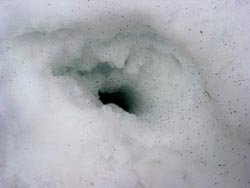George Bumann: Snorkeling Among Snowfleas
 This was from a trip to the Crazy Mountains of Montana. We stayed a Forest Service cabins and did some day hikes on snowshoes. One of the neatest discoveries on one of our days was seeing an incredible amount of ground pepper on the snow... well that's what it looked like until we got down on our hands and knees to realize that the 'pepper' was crawling and even jumping around - it was an emergence of blue-black snow fleas! They were everywhere in somewhat low, all the way up to to very high concentrations. In one spot I counted around 80 in a 1-foot square patch of white. If this pattern held for the remaining area around us, we were wading through, what could conservatively be estimated at 7.2 million snow fleas on the surface alone?roughly equivalent to the population of Delhi, India within a stone's throw of where we stand. In certain spots there seemed to be unusually high numbers of them. I assumed that these were spots where they had just fallen into a depression of some sort, but after looking closer we soon realized that this cluster, and all the other clusters of snow fleas for 70-80 yds in all directions were actually the top of a plume of fleas emerging from the underworld right up through the snow! It was incredible to see this streaming, pepper-coated shaft of living grit moving toward the land of love... later reading helped us realize that this was part of their mating rites. But, how could these little guys possibly operate in such low temperatures without freezing? I know that many invertebrate species have varying amounts of natural anti-freeze but wasn't quite sure about the fleas?actually a primitive wingless insect called collembola, or springtails. The small appendage on the end of their abdomen gives them the latter name; it wraps around beneath them and is 'flicked' allowing them to jump quite far - the equivalent of us leaping to the top of a 20 story building in a single bound!. One possible answer the to freezing-their-tails-off question came on this website, http://www.spacedaily.com/news/spacemedicine-05zk.html where it is suggested that an anti-freeze protein keeps them going and might actually have useful properties in the transport of transplanted organs, i.e. allowing them to be shipped at lower temperatures without damage. Who knew that a little snorkeling in the snow could lead to saving a life with an organ transplant?!www.GeorgeBumann.com
This was from a trip to the Crazy Mountains of Montana. We stayed a Forest Service cabins and did some day hikes on snowshoes. One of the neatest discoveries on one of our days was seeing an incredible amount of ground pepper on the snow... well that's what it looked like until we got down on our hands and knees to realize that the 'pepper' was crawling and even jumping around - it was an emergence of blue-black snow fleas! They were everywhere in somewhat low, all the way up to to very high concentrations. In one spot I counted around 80 in a 1-foot square patch of white. If this pattern held for the remaining area around us, we were wading through, what could conservatively be estimated at 7.2 million snow fleas on the surface alone?roughly equivalent to the population of Delhi, India within a stone's throw of where we stand. In certain spots there seemed to be unusually high numbers of them. I assumed that these were spots where they had just fallen into a depression of some sort, but after looking closer we soon realized that this cluster, and all the other clusters of snow fleas for 70-80 yds in all directions were actually the top of a plume of fleas emerging from the underworld right up through the snow! It was incredible to see this streaming, pepper-coated shaft of living grit moving toward the land of love... later reading helped us realize that this was part of their mating rites. But, how could these little guys possibly operate in such low temperatures without freezing? I know that many invertebrate species have varying amounts of natural anti-freeze but wasn't quite sure about the fleas?actually a primitive wingless insect called collembola, or springtails. The small appendage on the end of their abdomen gives them the latter name; it wraps around beneath them and is 'flicked' allowing them to jump quite far - the equivalent of us leaping to the top of a 20 story building in a single bound!. One possible answer the to freezing-their-tails-off question came on this website, http://www.spacedaily.com/news/spacemedicine-05zk.html where it is suggested that an anti-freeze protein keeps them going and might actually have useful properties in the transport of transplanted organs, i.e. allowing them to be shipped at lower temperatures without damage. Who knew that a little snorkeling in the snow could lead to saving a life with an organ transplant?!www.GeorgeBumann.com

